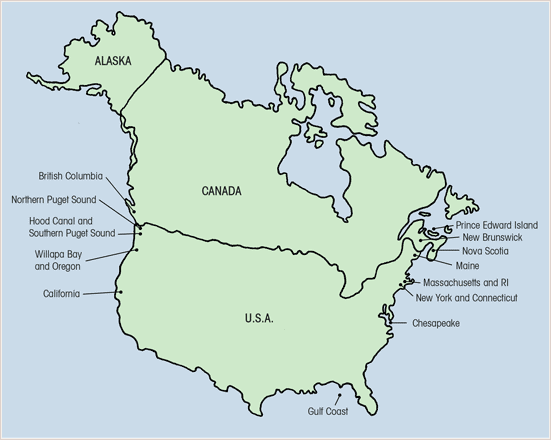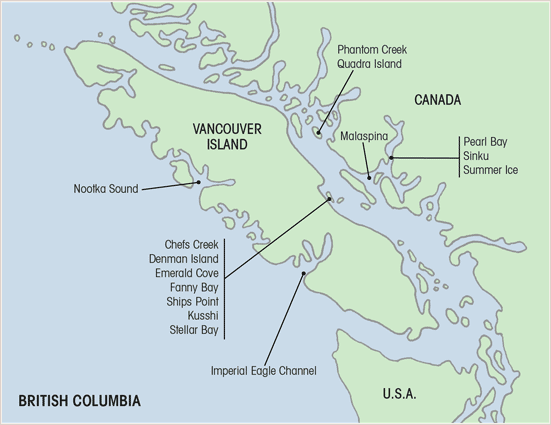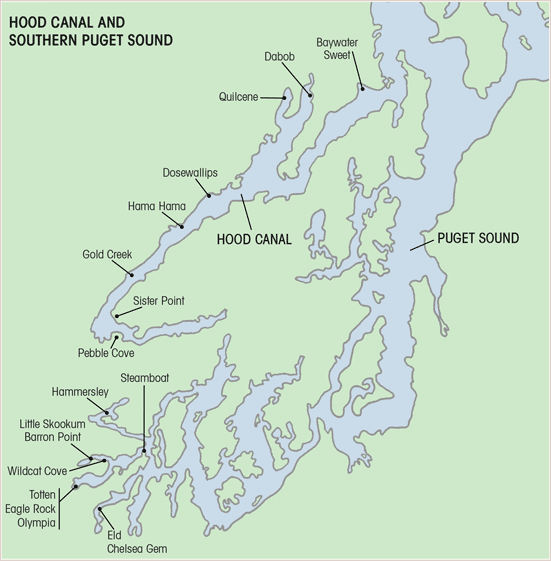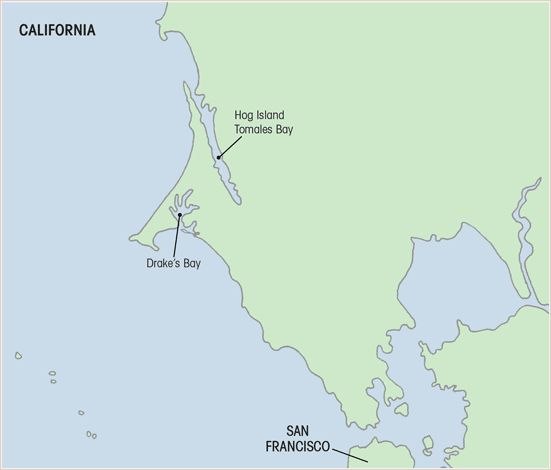An Introduction to West Coast Oysters
Like wine and cheese, oysters owe much of their flavor to terroir, the specific environment in which they grow. Oysters are the food that tastes most like the sea. Today, there are at least two hundred unique oyster appellations in North America, each producing oysters with a distinct and often dazzling flavor.

British Columbia
Any contest for Most Photogenic Oyster Region would go to British Columbia in a heartbeat. Every oyster farm seems to be framed by soaring Sitka spruce, palatial white peaks, and maybe the fin of an orca cutting the water surface. Most of the BC coast is fjords, cut by glaciers, which makes for a landscape that is awe-inspiring—yet homogeneous. Coastal British Columbia doesn’t have the varied geography of Washington State—no Puget Sound inlets working deep into the land, no gentle Willapa Bay mudflats—and its oysters don’t vary greatly in flavor. Most of BC’s oyster farms are clustered in the Strait of Georgia, the hundred-mile inland sea stretching north of Vancouver. Sheltered by the massive bulk of Vancouver Island, the strait offers endless calm hideaways for oysters. The landscape is wild and unpolluted, the water very cold, and the oysters clean and mild. That smoothness is what many people want in a Pacific oyster. You won’t get overwhelming or strange flavors from many BC oysters, just a little salt, a little sweetness, and, if you pay close attention, often a green apple candy note.

Hood Canal & Puget Sound
Puget Sound reaches into Washington State like an arm dipping into a barrel. Its upper arm abuts Seattle, its elbow bends at Tacoma, and at Olympia it spreads five fingers into the land. Those five long, narrow inlets—Hammersley, Little Skookum, Totten, Eld, and Budd—comprise some of the most famous oyster appellations in the Northwest. Budd reaches directly into downtown Olympia and is closed to shell fishing, but the other four are thick with amazingly fast-growing oysters and clams. Each inlet has its distinctions, but they all contribute that characteristic South Sound flavor—full, rich, intense, more sweet than salty, a hint of cooked greens or seaweed, bordering on musky. It’s like a sea version of collards with pork fat.
An extraordinary two hundred miles from the open sea, the South Sound has relatively low salinity; the sea is less of a factor. After navigating that entire coastline, the water that reaches the South Sound has experienced countless land influences. It’s also nutrient-rich, thus algae-rich. Rivers, tidal zones, and mudflats each add their own algae-mineral cocktail to the mix. Salmon push up those inlets in fall, flooding them with nutrients when they die. If Eastern oysters smell like wet rocks at low tide, South Sound oysters smell like wet earth at low tide. It’s an acquired taste. But those who acquire it consider milder oysters too boring. They toast each other’s arch taste with a musky Pinot Gris and never look back.
Just a few miles of fir forest separate Hood Canal from Puget Sound, but geologically they are worlds apart. South Puget Sound is a land of gentle terrain and shallow inlets. Hood Canal, on the other hand, is steep and deep: steep mountains above, deep waters below. It’s a genuine glacier-carved fjord, the only one in the continental United States. Oysters adore Hood Canal. The water is kept brackish, cold, and oxygenated by the Olympic rivers. Even more important, the glacier left behind a gravelly till, quite unlike the muddy substrate that dominates Puget Sound. Firm river deltas line the canal, every one of them laced with brackish sloughs and thick with oysters. The classic Hood Canal flavor is very different from that of southern Puget Sound; more lettuce and lemon zest, saltier, less sweet, and very firm for a Pacific.

California
For a big state, California’s oyster industry is confined to a small area. Tomales Bay is the center of the action, with several small growers, including Hog Island. Coast Seafood’s, the largest oyster company in the country, has major Kumamoto farms to the north in Humboldt Bay. Other than that, there are a couple of crazy outriders growing oysters in suspension culture in the open ocean of Southern California, one farm in Drake’s Estero, and that’s it. It’s all in the geography. California isn’t blessed with many bays. It has one world-class bay (San Francisco), and one dinky one (Humboldt). San Francisco Bay held billions of Olympia oysters in the 1850s, zero in the 1860s. By the time Pacific oyster seed was available from Japan, San Francisco Bay was far too polluted to grow oysters. Tomales Bay, the other workable water body, is a geological freak. When Point Reyes, the tomahawk-shaped wedge of land that is the tip of the Pacific Continental Plate, slammed into the rest of California, which edges the North American Continental Plate, it didn’t make a perfect fit. Tomales Bay is the imperfection, more a crevice than a typical bay. That imperfection is sliding northward at a rate of two inches per year as the plates continue to grind together. Every now and then they come unstuck and jump—twenty feet at once in 1906, leveling much of San Francisco in the process. In geological terms, Tomales Bay is living on borrowed time.

|